Reactions to the Holocaust in North Carolina’s Newspapers
Document Presets
To download, choose the "Save as PDF" option when asked to choose a printer.
Primary Source Set
Reactions to the Holocaust in North Carolina’s Newspapers
Prior to World War II (WWII), the Nazi regime rose to power in Germany, leading to the systematic persecution and state organized murders of the Jewish people and many other groups including members of the LGBTQ+ community, the Roma, politically left, and people of other racial minorities. This genocide orchestrated by the German government then carried out by people throughout Germany and German-occupied territories culminated in the deaths of millions of people and spurred study into the patterns of fascist states and genocide. In the aftermath of WWII and the uncovering of the concentration and work camps where much of the genocide was carried out, a rallying cry of Never Again arose. However to this day many wonder, what was known about the actions of the Nazis in the United States while the Holocaust was being carried out? Utilizing historic newspapers is one way to get an idea of what the general public was reading at the time. This primary source set focuses on the stories found in North Carolina specific newspapers that discuss the actions of the Nazi regime, particularly in regard to the Jewish people and others persecuted by the government.
Proceed with caution and care through these materials as the content may be disturbing or difficult to review. In these primary sources there are descriptions of antisemitic, white supremacist, and oppressive violence, ideology and language. Please read DigitalNC’s Harmful Content statement for further guidance.
Time Period
1933-1980
Selected Sources
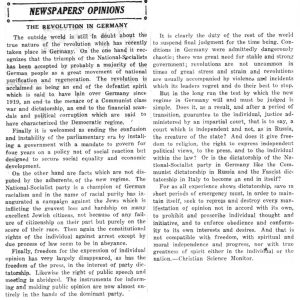
‘The Revolution in Germany’ - The times-news. (Hendersonville, N.C.) [5/26/1933]
Hendersonville, NC (Henderson County), 1933
Shortly after the Nazi government consolidated their power in 1933, the Times-News published this article in their opinion section of the paper. The article pointed out the ‘positive aspects’ of the Nazi rise in Germany and also pointed out the clear foundational belief of racial purity espoused by the Nazi party. The author promoted the viewpoint that it was the ‘duty of the rest of the world to suspend final judgment for the time being.’ They ascertained that judgment would come after determining the length, severity, and impact on freedom of the Nazi regime, though for whom was not discussed in the article.
Contributed to DigitalNC by University of North Carolina at Chapel Hill
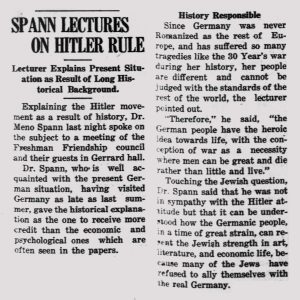
‘Spann Lectures on Hitler Rule’ - The daily Tar Heel. (Chapel Hill, N.C.) [5/8/1934]
Chapel Hill, NC (Orange County), 1934
University of North Carolina (UNC) at Chapel Hill’s student newspaper, the Daily Tar Heel, covers local and national news along with events involving UNC students. The article shown describes a lecturer scheduled to speak at UNC about Nazi Germany after traveling there and talking with Nazi officials, particularly the Third Reich’s physicians. This is shortly after the first year of Nazi rule, in which they enacted laws limiting the type of jobs Jewish people could hold and how many Jewish students were permitted in schools. He states that Germany cannot be held to the same standards as other countries, and while he is not “in sympathy” with Hitler and his policies, “it can be understood” why Germans are antisemitic. Attitudes such as this lecturer’s exasperated antisemitism in American universities, leading many universities to buckle down on their unwritten policies of only hiring a certain number of Jewish faculty, discussed further in this article. Despite student protests against the fascist regime, many universities’ leadership continued to limit the hiring of Jewish people, denying acceptance to many European Jewish scholars and professors seeking refuge in the United States through employment at American universities.
Contributed to DigitalNC by University of North Carolina at Chapel Hill

‘News Review of Current Events the World Over’ - The Alamance gleaner. (Graham, Alamance County, N.C.) [9/26/1935]
Graham, NC (Alamance County), 1935
This excerpt of an article by Edward Pickard was circulated in multiple North Carolina newspapers, including The Alamance Gleaner. The article reports on the recent laws passed in Germany September 1935, which became known as the Nuremberg laws for the city the Nazis had congregated in to officially adopt them. These laws further ostracized Jewish people from German society by revoking their citizenship and attempting to outlaw marriage or relations between Jewish people and non-Jewish German citizens; this came after publicly shaming relationships between Jewish and non-Jewish people. The article describes these laws as “bearing down hard” on the Jewish population in Germany. This article also includes a reaction from the Committee of Jewish Delegations and their appeal for help to the League of Nations regarding this escalating persecution.
Contributed to DigitalNC by Madison County Public Library, University of North Carolina at Chapel Hill

‘Hitler Dolled Up as He Attends Nazi Congress’ - The Alamance gleaner. (Graham, Alamance County, N.C.) [9/30/1937]
Graham, NC (Alamance County), 1937
This photograph and accompanying description of Adolf Hitler attending the Nazi Congress in 1937 was circulated through many newspapers in North Carolina, not just the Alamance Gleaner. There is a lack of any context for the congress or Hitler’s recent actions in this newspaper and many of the other papers in which this was printed.
Contributed to DigitalNC by Alamance County Public Libraries
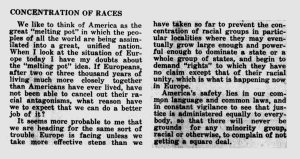
‘Concentration of Races’ - The Moore County news. (Carthage, N.C.) [10/13/1938]
Carthage, NC (Moore County), 1938
This excerpt from an article in the Moore County News discussing the complexities of racial tensions in Europe and reflecting on racial tension in the US warns that the US could be moving along a similar trajectory as Europe. The author states that the US should take steps to prevent the concentration of racial groups as to avoid them gaining a majority in particular states or groups of states where they would ‘demand “rights” to which they have no claim except that of their racial unity.’ The author continues to claim that US laws, language, and commitment to see justice administered equally would prevent ‘any minority group, racial or otherwise, to complain of not getting a square deal.’ While the author does not explicitly state to which minority groups are being referred either in the US or Europe, from the mounting persecution of Jewish people and the continuing oppression of Black people, it is most likely these are the minority groups respectively in Europe and the US that would be seeking the rights that the author has deemed unnecessary or already given and who states would need to proactively quell their calls for equal treatment. This is less than a month before the events of Kristallnacht, a nation-wide pogrom in Germany against Jewish people.
Contributed to DigitalNC by University of North Carolina at Chapel Hill, Moore County Library, Moore County Genealogical Society, State Archives of North Carolina
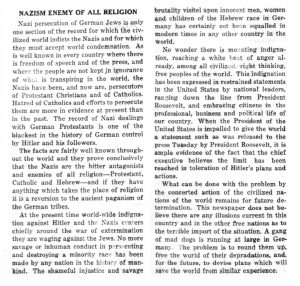
‘Nazism Enemy of All Religion' The times-news. (Hendersonville, N.C.) [11/17/1938]
Hendersonville, NC (Henderson County), 1938
The Hendersonville Times-News published nearly daily and covered topics on religion, politics, and current events from local to national levels. Here, they publish an article on the “shameful injustice and savage brutality” against Jewish people by Hitler and Nazi Germany, though the article also focuses much of its attention on the treatment of Protestants and Catholics in Germany. The article goes on to call for the world to condemn the Nazi regime, though what actions to take remains to be determined. This was published in 1938, shortly after the pogrom against Jewish people given the name Kristallnacht, and is part of the evidence of how long the United States and many powerful world leaders were aware of the violences happening in Germany. There are many critiques of President Franklin D. Roosevelt and his policies around these incidents, stating that sooner action could have saved many more lives. Others claim that there were constraints outside of his control which quelled his actions, like a recovering economy from the Great Depression and other domestic issues. Either way, the lack of intervention allowed the systematic killings to increase at exponential rates over the following years.
Contributed to DigitalNC by University of North Carolina at Chapel Hill
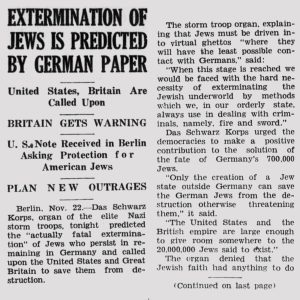
"Extermination of Jews is Predicted by German Paper’ - The Elkin tribune. (Elkin, N.C.) [11/24/1938]
Elkin, NC (Surry County, Wilkes County), 1938
The Elkin Tribune, currently still publishing, provides local and national news stories to Elkin, NC and surrounding areas. In this 1938 paper following the events of the Kristallnacht, the nation-wide pogrom against Jewish people, the Tribune chose to feature an article on a German paper which stated that Germany will strive to completely separate German Jewish people from German society and life. The Nazi paper called for expelling Jewish people from Europe into a separate country, as this was the only acceptable way to stave off a total genocide of the Jewish people. These statements illustrate points that some Jewish scholars and activists have made regarding Zionism as a vehicle for antisemitism, that it is used by many to further the oppression of Jewish people. The paper also drew attention to Joseph Goebbels’ efforts to spread antisemitism in Germany and abroad, especially hoping to create resentment towards Jewish people in Britain and the US, leading to president Roosevelt attempting to reach an agreement with Nazi leaders to give exceptions to American citizens.
Contributed to DigitalNC by Elkin Public Library, Northwestern Regional Library
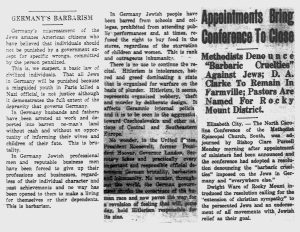
The Farmville enterprise. (Farmville, Pitt Co., N.C.) [11/25/1938]
Farmville, NC (Pitt County), 1938
The Farmville Enterprise in this issue covers opinions on Germany’s actions following the events of the Kristallnacht attacks, a nation-wide pogrom. Included is an article titled ‘Germany’s Barbarism,’ where the paper proclaims that all of the Jewish people should not be punished for the actions of a “misguided youth,” referring to the young boy, Herschel Grynszpan, who killed a Nazi officer in Paris, France. At the time, the Nazis claimed this assassination was the cause of the events of Kristallnacht, though it was later proven this was planned prior and they were waiting for an ‘appropriate excuse’ for the nationwide pogrom. Grynszpan’s actions were generally condemned, though papers like the Farmville Enterprise included that all Jewish people should not be subjected to punishment for his action. The paper also includes an article on the North Carolina Conference of the Methodist Episcopal Church, South, denouncing persecution of Jewish people worldwide and support for “all movements with Jewish relief as their goal.”
Contributed to DigitalNC by Farmville Public Library

“Mr. Dunlap Discusses the Jewish Question” The Monroe enquirer. (Monroe, N.C.) [4/22/1943]
Monroe, NC (Union County), 1943
In this article published in the Monroe Enquirer, S.S. Dunlap provides the opinion that a Jewish state would be a way to “solve” the “Jewish Question.” Here, Dunlap reasons that Zionism, an ideology that calls for a separate Jewish state within which Jewish people would live, is an appropriate response to the horrors of the Holocaust. There is a lack of any address of antisemitism within North Carolina, the United States, or the world as a whole, nor any suggestions that would provide any place that Jewish people live to be a safe place free of antisemitism. This shows a historical trend of non-Jewish people and governments using Zionism as a way to ignore addressing antisemitism within themselves and their society. This article was published two years before the end of WWII and the Nazi violences of the Holocaust.
Contributed to DigitalNC by University of North Carolina at Chapel Hill, State Archives of North Carolina
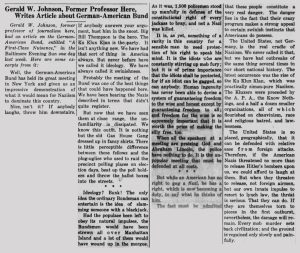
‘Gerald W. Johnson, Former Professor Here, Writes Article About German-American Bund’ (Chapel Hill, N.C.) [3/3/1939]
Chapel Hill, NC (Orange County), 1939
Gerald Johnson reflects on the growing presence of Nazism in the United States in this article published in the Chapel Hill Weekly. He articulated that the US was the birthplace of Nazism, a perspective often left out of the criticism of Nazi Germany. He argues that the Ku Klux Klan was one of the precursors to what is called Nazism and that the threat Nazis pose in the US is stoking the violent tendencies that lay within US society, naming lynching specifically, and how these violences stifle any progress. This argument is founded on the fact that Nazi policies were crafted based on US white supremacy and racist laws, showing also the fear that Nazi escalation of violence against Jewish people was a very real possibility for minority groups, particularly Black people, in the US.
Contributed to DigitalNC by University of North Carolina at Chapel Hill
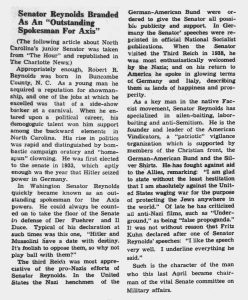
“Senator Reynolds Branded as an ‘Outstanding Spokesman for Axis’” - The Bryson City times. (Bryson City, N.C.) [8/21/1941]
Bryson City, NC (Swain County), 1941
The pro-Nazi, antisemitic beliefs of US senator from North Carolina, Robert Reynolds, was discussed in this article reprinted in the Bryson City Times, now the Smoky Mountain Times. The article discussed how Reynolds’ speeches were approved of by the Nazi government and the German American Bund, a US-based Nazi organization, and his words were reprinted in their newspapers. The Bund in particular praised Reynolds and supported his actions and speeches openly, as well as the organization with accompanying publication Reynolds started called the American Vindicators. The article quoted him on being opposed to US intervention in the protection of Jewish people in Germany and that all anti-Nazi media was “false propaganda.” The article criticized his character in relation to his isolationist, anti-immigrant, antisemitic, and pro-Nazi views, also drawing attention to his recent ascent to chairman of the Military Affairs Committee. This article shows both the perspective of criticism around Reynolds and his beliefs as well as his repeated successful reelection to the position of senator.
Contributed to DigitalNC by Fontana Regional Library, Western Carolina University, University of North Carolina at Chapel Hill
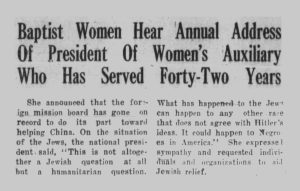
‘Baptist Women Hear Annual Address of President of Women’s Auxiliary Who Has Served Forty-Two Years’ - The Carolina Times (Durham, N.C.) [9/18/1943]
Durham, NC (Durham County), 1943
In this issue of the Carolina Times, a historically Black newspaper published in Durham, NC, the paper covered an address by Mrs. S.W. Layten, the president of the women’s auxiliary of the National Baptist Convention, where she addressed many current events of the times. She expressed the need for support of efforts to give relief to Jewish people under Nazi occupation. She warned that the same violences could spread to any group the Nazis felt inferior, making this more than a Jewish issue but a ‘humanitarian’ issue. This is part of a history of Black and Jewish social movement leaders supporting each other during the Civil Rights Movement era of the mid-20th century, despite a complicated history of solidarity.
Contributed to DigitalNC by Durham County Library, State Archives of North Carolina, University of North Carolina at Chapel Hill
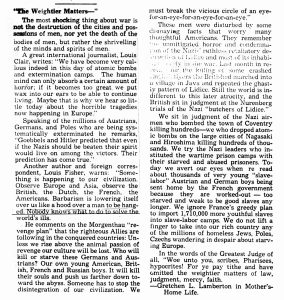
“The Weightier Matters” - The Sylva herald and ruralite. (Sylva, N.C.) [2/20/1946]
Sylva, NC (Jackson County), 1946
In this issue of The Sylva Herald and Ruralite, the paper printed an article by Gretchen L. Lamberton; the author proclaims that the greatest loss after the war was the “minds and spirits of men.” Drawing attention to the normalization of mass violence, she states that the governments currently presiding over the post-war trials of Nazis were hypocrites as they had also committed atrocities against humanity. Specifically, she points out the conditions of survivors of the Nazi regime, the similarities between Nazi destruction of Lidice and British destruction in Java, and the atomic bombings of Hiroshima and Nagasaki in Japan. She also highlights the refusal of the US to accept immigrants, particularly survivors of the Holocaust, showing an early recognition of the imperial core’s continuation of violence, similarities with Nazi Germany, and refusal to provide substantive support to survivors.
Contributed to DigitalNC by Jackson County Public Library
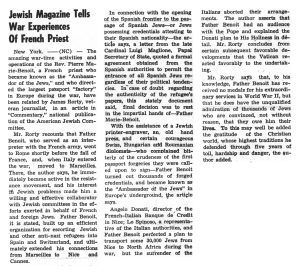
'Jewish Magazine Tells War Experiences of French Priest' - North Carolina Catholic (Nazareth, N.C.) [3/2/1947]
Nazareth, NC (Wake County), 1947
The North Carolina Catholic Register is a paper that covers national, global, and papal news reporting, the Nazareth paper including local news, all through the lens of the Catholic faith. In this issue, the paper writes about a French Catholic priest, Father Pierre-Marie Benoît, that assisted over 30,000 Jewish people to leave Nazi Germany and sought help from the Vatican and the Italian military to protect the people he had smuggled into other parts of Europe. The article focuses on the priest’s efforts in saving Jewish people, including forging documents to state they were Christian and his unofficial title of “Ambassador of the Jews.” This is one of many resistance stories of people defying Nazi rule and providing aid to their neighbors, friends, and strangers.
Contributed to DigitalNC by Catholic Diocese of Raleigh
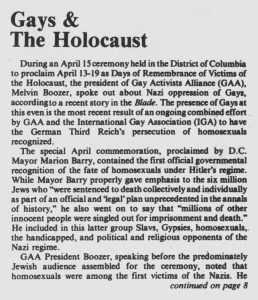
‘Gays and the Holocaust' - The Front page. (Raleigh, N.C.) [5/8/1980]
Raleigh, NC (Wake County), 1980
The Front Page (1979-2006) was an openly LGBTQ+ newspaper based out of Raleigh, NC, and was distributed mainly throughout North and South Carolina. It covered local and national news and areas of interest for LGBTQ+ folks. Here, the paper printed an article remembering the horrors of the Holocaust and reporting on the effort of groups like the Gay Activists Association and the International Gay Association (now the International Lesbian, Gay, Bisexual, Trans and Intersex Association) to have the persecution of LGBTQ+ people in the Holocaust recognized during Holocaust remembrances. This struggle continued because of widespread denial of LGBTQ+ Holocaust victims due to global anti-LGBTQ+ policies and sentiments. The article details this struggle to be recognized decades after the recognition of the Holocaust and its other victims, and the Front Page concludes with urging anyone with knowledge of LGBTQ+ victims of the Holocaust to submit their research/knowledge to the U.S. Holocaust Memorial Council. Many LGBTQ+ victims of the Holocaust remained imprisoned after the end of WWII, were denied reparations for their suffering, and were often shunned from Holocaust remembrance events. The Nazi amendments to Paragraph 175 of the German Penal Code were kept in practice until 1994, and the LGBTQ+ victims of the Holocaust and the continuing persecution post-WWII were not “pardoned” and compensated until 2017.
Contributed to DigitalNC by Duke University, University of North Carolina at Charlotte
Background
The Holocaust, as defined by the United States Holocaust Memorial Museum, was the systematic, state-sponsored persecution and murder of six million European Jews by the Nazi Germany regime and its allies. The Holocaust occurred between 1933 and 1945 and was an evolving process that took place throughout Europe during this time. In addition to the mass murder of Jewish people in Europe during the Holocaust, the Nazi Germany regime also persecuted and murdered millions of other victims, who included Black people in Germany, members of the LGBTQ+ community or those accused of being part of the community, Jehovah’s Witnesses, people with disabilities, Poles, Roma or those labeled as “Gypsies,” social outsiders in Germany, and Soviet Prisoners of War. The Nazi ideology was racist, antisemitic, and ultra-nationalist and the Nazi government used these views to dehumanize and devalue entire groups of people.
While today most people would automatically state they are against such actions, during the time the Holocaust was happening it was a more complicated situation. In the 1930s, the US government and the American public learned about Germany’s persecution of German Jews from various sources including American diplomats, newspapers, newsreels, and the radio. After the start of World War II, information about what was happening in Germany became harder to access but it also coincided with an increase in the persecution and violence against German Jews, and as Germany expanded its territory during the war, other European Jews, ultimately resulting in the deaths of millions.
At the same time Nazi Germany was coming to power in Germany in the 1930s, in the United States the Great Depression was raging on and Jim Crow laws were in full force across the nation keeping Black Americans segregated from White Americans. The American public at large was supportive of isolationism, especially after the “Great War,” and had little interest in more immigrants to the country, especially if they were Jewish. Antisemitism and racism both had their own strong adherents in the United States.
The compiled newspaper articles from North Carolina newspapers about this time in Germany are important to read with both the context of what was happening in Germany at the time as well as what was happening in the United States, particularly the still segregated South. This context will influence how a reader of the article at the time would encounter it.
These primary sources show a variety of reactions to the Holocaust and Nazism by people in North Carolina. They can be used to analyze history, the legacy of the Holocaust and antisemitism, the role of propaganda and information control in influencing public opinion, and government complicity in the persecution of minoritized groups.
Discussion Questions
Jewish Persecution
Antisemitism existed before the Holocaust and still persists today, seen in events like the Charlottesville, VA ‘Unite the Right’ rally and attack in 2017. Consider the following questions to reflect on antisemitism and how it is used by Nazis and white supremacists:
- How did Nazi genocidal actions start and how did they progress throughout the Holocaust? What factors allowed this to continue for over a decade?*
- What do the primary sources tell you about various attitudes towards the Holocaust and Jewish people in North Carolina? What attitudes or opinions may not be represented in these primary sources?*
- Why did the Nazis choose to use antisemitism as a tool to build the Third Reich? Why do white supremacists hold antisemitic beliefs?**
- What has the Holocaust taught us about genocide and why do genocides continue to exist?**
- What actions can be taken against atrocities like the Holocaust? How can oppressive structures, like antisemitism, as a whole be combated?**
- How are the legacies of the Holocaust and antisemitism seen in these primary sources and throughout life in North Carolina?**
- What were the historic conditions of living in North Carolina for Jewish people and how have these conditions changed or not changed?**
Analyzing Historical Patterns
Read the article from the November 25, 1938 issue of the Farmville Enterprise:
- What reasons did the author give for the treatment of Jewish people being unjust?*
- What were the types of brutality that the author listed that Germany was perpetrating against Jewish people?*
- What parallels to other moments in history can you draw from the descriptions laid out here?**
- Are there moments in North Carolina history that could be described in the same or similar language?**
- Do you think this author would use the same rhetoric to describe antisemitism in North Carolina? And for other forms of oppression?**
- What factors may have impeded or facilitated the author/publisher of this article to draw these comparisons?**
History in Context with the Times-News
In the article from the Hendersonville paper, ‘Nazism Enemy of All Religion,’ the author states in regards to Germany’s treatment of Jewish people that “[n]o more savage or inhuman conduct in persecuting and destroying a minority race has been made by any nation in the history of mankind. The shameful injustice and savage brutality visited upon innocent men, women and children of the Hebrew race in Germany has certainly not been equaled in modern times in any other country in the world.”
- How does this article differ from the opinion piece published in the Times-News in 1933?*
- What may have contributed to the difference in language published by the paper?**
- How does the article’s description of state violence against Jewish people highlight and obscure state violence?*
- How can we talk about mass violence without invisibilizing other violence?**
- How can instances of state violence be connected? Can this better our understanding of both/all instances of state violence?**
- It is documented that Nazi Germany based many of their laws persecuting Jewish people (and other minorities) off of U.S. laws (read more about this here). How can we see the connections between racist laws in the U.S. and North Carolina and those that made the Holocaust possible?**
- Does this change the way you understand history regarding colonization, slavery, the Holocaust, and Jim Crow? If so, how?**
How does antisemitism relate to other forms of oppression? Use this resource by Southerners on New Ground to help think through interrelating oppressive structures, as well as using the concept of intersectionality, coined by Kimberlé Crenshaw and explained here, to explore the intersections of these systems of oppression.
- How does this article differ from the opinion piece published in the Times-News in 1933?*
US White Supremacy and Nazism
Review ‘Gerald W. Johnson, Former Professor Here, Writes Article About German-American Bund’ from the Chapel Hill Weekly, then consider the following:
- How does this article differ from the others in the primary source set? Are there any that make similar points or use similar rhetoric?*
- What is the relationship between Nazism and the US that Johnson mentions in the article?*
- Are there other ties between the two not mentioned?**
- After reviewing the article on Senator Robert Reynolds, does that information confirm or refute Johnson’s points? Why?*
- What does this article reveal about the socio-political climate in the US in 1939?**
- What does this show about the salience of the ideology of fascism and antisemitism in the US and globally at that time?**
- How does this connect to our current socio-political climate?**
Other Victims of the Holocaust
After reading the article ‘Gays and the Holocaust’ by the Front Page, consider the following:
- Aside from the article in the Front Page, did any other primary sources in this set mention LGBTQ+ individuals in relation to the Holocaust and Nazi violence?*
- Which groups of people were mentioned as targets for persecution?*
- What did the article use to convey the importance of recognizing LGBTQ+ victims of the Holocaust?*
- Why do you think people often talk about the groups persecuted by Nazis separately? What purpose does this separation serve?**
- What connects these different groups of victims of Nazi violence and what differentiates them?**
- How did the persecution of these groups continue after the official end of the Holocaust?**
- Were people targeted in the same ways or in different ways?**
- Read this story about Eva Kotchever.
- How did Eva’s identities as a lesbian, Polish Jewish immigrant, and leftist intersect to make her a target of US and Nazi Germany state violence? What were these violences and how did they work together to lead to Eva’s murder?**
- Why is documenting LGBTQ+ experiences important? What is missing from understanding Eva’s life and death?**
- What factors may have kept LGBTQ+ victims of the Holocaust from sharing their stories or having their stories shared?**
- Aside from the article in the Front Page, did any other primary sources in this set mention LGBTQ+ individuals in relation to the Holocaust and Nazi violence?*
‘Hitler Dolled Up as He Attends Nazi Congress’
- After reviewing the photo description in the paper, what type of opinion does the rhetoric used point to the author and by extension the publishers holding?*
- Does a person’s or an institution’s opinion on Adolf Hitler reflect their opinion on Nazi Germany and/or the Holocaust? Why or why not?**
- How has Hitler become attached to the decisions that led to and the events of the Holocaust? How does this either help or undermine people’s understanding of the totality of the Holocaust and its architects?**
- Compare this with a report on the Nuremberg laws published by the same paper. Are these sources using different rhetoric? How are they similar or different?*
- Does this change your perception of their opinion(s) on the Holocaust? Why or why not?**
- After reviewing the photo description in the paper, what type of opinion does the rhetoric used point to the author and by extension the publishers holding?*
Zionism and Antisemitism
After reading the article ‘Extermination of Jews is Predicted by German Paper’ in The Elkin Tribune, consider the following:
- What did the German paper state would happen to Jewish people in Germany?*
- Why do you think Nazi Germany would call for the exile of Jewish people from Germany?**
- Read the American Jewish Congress’ statement on anti-Zionism and antisemitism, then read Jewish Voices for Peace’s (JVP) statement on Zionism.
- Based on these articles, is conflating all Jewish people with Zionism antisemitic? How so?*
- JVP ascertains that Zionism is itself harmful to people living within the current state of Israel and throughout the Jewish diaspora. What were the examples they listed and is there any evidence of this that you have observed in your local community?**
- How are Zionism and anti-Zionism related to the events of the Holocaust?**
- How are the ideologies of antisemitism, racism, Zionism, and anti-Zionism represented or not represented in the primary sources provided in this set?*
- Read either this article in the Nation by Dave Zirin or this article in the New York Times by Michelle Goldberg.
- What do these articles propose as the dangers of synonymizing anti-Zionism and antisemitism? How are these different?*
- Similarly, what are the dangers in synonymizing Zionism and the state of Israel with all Jewish people? Why are these distinctions important?*
- Did these primary sources fall into perpetuating these conflations? How or how did they not do this?*
* Questions that check for comprehension
** Questions that involve a “deeper dive” in conceptual and historical analysis
- What did the German paper state would happen to Jewish people in Germany?*
These materials were compiled by cal lane. Updated September 2025.
https://www.digitalnc.org/?post_type=ncdhc-sourceset&p=46057
This document was prepared for print on September 16, 2025.